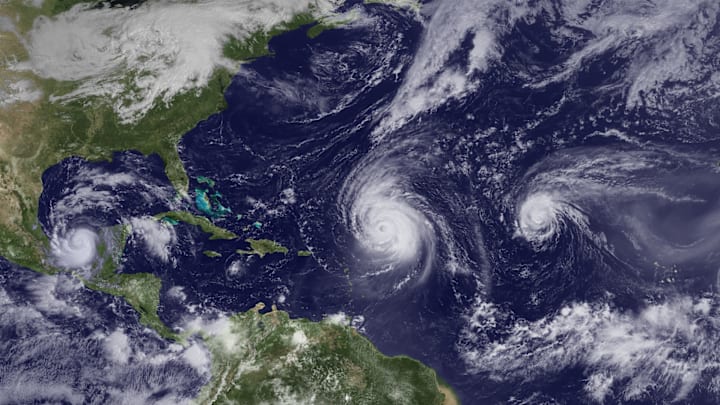If you live near the tropics, you’re used to extreme weather events. The most severe storms look similar around the equator: They form over the ocean, take the shape of a spiral, and produce strong, destructive wind gusts. But depending on where they originate, these storms go by different names. The words hurricane, cyclone, and typhoon all describe the same type of weather system, but there are some key differences in their definitions.
What is a cyclone?
A cyclone isn’t necessarily a typhoon or a hurricane, but all typhoons and hurricanes are cyclones. Cyclone is a broad term for a large storm system that rotates around a center of low atmospheric pressure (a.k.a the eye of the storm). These air masses produce rain, wind, and lightning. Storms that originate over tropical or subtropical waters are called tropical cyclones, and they are some of the strongest storms on Earth. When warm, moist air rises off the ocean’s surface, it leaves behind an area of low pressure. The surrounding air that fills the space eventually warms up as well. This humid air forms clouds, and as the cycle continues, the clouds swirl into a massive spiral fueled by the warm waters below.
Tropical cyclones with winds below 38 mph are officially called tropical depressions. When gusts range between 39 and 73 mph, they become tropical storms. The strongest tropical cyclones produce winds exceeding 74 mph, and this is where the naming gets complicated.
What is a hurricane?
Hurricane is a regional name for a severe tropical cyclone that comes from the North Atlantic, central North Pacific, or eastern North Pacific oceans. So if you hear of a tropical storm producing 74 mph-plus winds over North America or Central America, it’s a hurricane. Florida, Mexico, Hawaii, and the Caribbean islands are a few places where hurricanes can make landfall.
Hurricanes are categorized according to the Saffir-Simpson scale, which was developed by structural engineer Herbert Saffir and National Hurricane Center (NHC) director Robert Simpson in the late 1960s and early ‘70s. A Category 1 storm is the weakest type of hurricane, with wind speeds ranging from 74 to 95 mph. The scale goes up to Category 5, which describes storms with sustained winds of 157 mph or higher.
The NHC and World Meteorological Association use a naming system to keep track of the hurricanes that form each season. They use six lists of 21 names, which they cycle through every six years. The names of particularly strong and destructive storms are usually retired from the system.
What is a typhoon?
Meteorologically speaking, typhoons are identical to hurricanes—the biggest difference lies in where they happen. Typhoon is the name given to tropical cyclones with sustained wind speeds over 74 mph that form over the Northwest Pacific Ocean. Typhoons have the potential to be stronger than hurricanes because they form over warmer water, and they impact East Asian countries like Taiwan, Japan, China, and the Philippines. Though they can also be measured using the Saffir-Simpson scale, they generally fall into two categories: typhoons, with sustained winds between 74 and 149 mph, and super typhoons, with winds exceeding 150 mph.
Like hurricanes, typhoons have their own naming system. The Japanese Meteorological Agency assigns the names, and instead of switching to a new list at the beginning of a new year, they go straight through one big list over several seasons.
Even when viewed from space, typhoons and hurricanes are indistinguishable. Both form in the Northern Hemisphere, which means they spin counterclockwise. Tropical storms that occur south of the equator swirl clockwise, and when they hit southern countries like Australia, they’re simply called cyclones.
